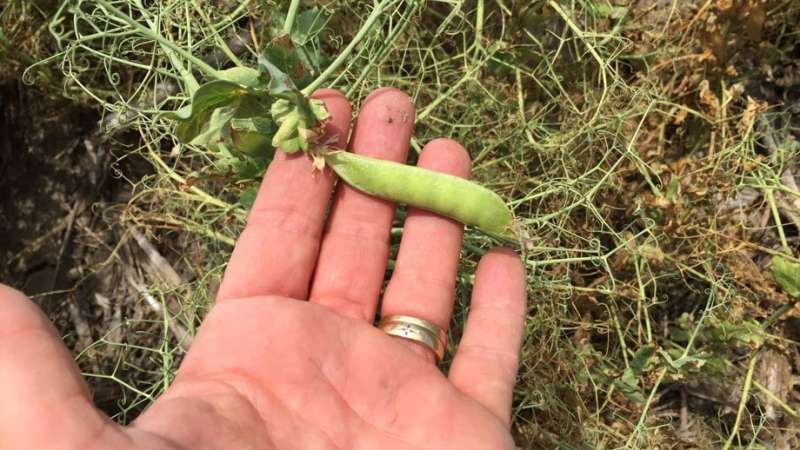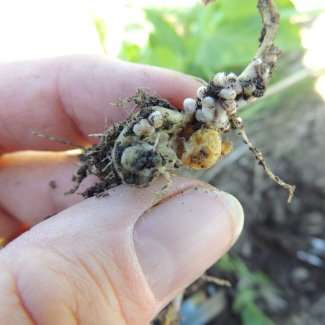Diversifying crop rotation improves soil, reduces fertilizer costs

Farmers who have used a three- or four-crop rotation system for more than 10 years are most likely to reap the benefits of improved soil health and higher yields, according to a survey of producers in eastern South Dakota.
With fertilizer prices at an all-time high, this might be an opportune time for producers to consider adding oats, peas and spring or winter wheat to their rotations, according to associate professor Tong Wang of South Dakota State University's Ness School of Management and Economics. She led the SDSU team that analyzed responses from the 2018 producer survey. An article describing farmers' perceptions about diversified crop rotations was published in the Journal of Environmental Management.
Greater crop diversity can help suppress weeds, break pest cycles and improve soil organic matter, thereby reducing input costs, Wang explained. Survey results showed "most producers saw the benefits in terms of controlling pests and disease, but fewer felt diversified cropping cut fertilizer costs." However, she noted, supply shortages and high prices may help motivate more producers to consider crops that require less fertilizer.
Weather and soil also make a difference in diversified crop adoption rates, Wang noted. "Those living in drier areas or experiencing drought and those with more sloped land, and therefore more erodible soil, were more likely to use diversified crop rotation." In addition, those who graze cattle on cropland or who are engaged in organic farming also cite increased benefits from this conservation practice.
The research is supported by the U.S. Department of Agriculture Natural Resources Conservation Service and South Dakota Corn Utilization Council.
Analyzing producer adoption rates
A corn-soybeans rotation is the dominant pattern in the Midwest and was reflected in the producers' responses, Wang said. Nearly 58 percent of the 680 respondents who shared their rotation choices said they typically rotate corn and soybeans. However, slightly more than 18 percent planted a single crop continuously—soybeans, alfalfa/clover, corn or small grains in that order.
Less than 24 percent of the respondents use diversified cropping—about two-thirds diversifying via a three-crop rotation plan and the remainder via four or more crops.
More than half of the producers who used diversified cropping had done so for more than 10 years. This subset also reported increased yields and profitability, Wang noted. This suggests not only that long-term use of diversified cropping maximizes benefits, but also those who have used the conservation practice longer become more skilled at doing so.
Producers reported being strategic in their application of diversified cropping, using it to cope with dry conditions and to improve soil health and reduce soil erosion on marginal land. In addition, those who had used diversified cropping 10 years or more also tended to do so on a larger percentage of their cultivated acres.

Identifying marketable crops
Producers must also carefully choose the crops they include in a three- or four-crop rotation based on their unique operations, the cost of inputs and the marketability of the crop, Wang said. "It is important to identify new crops that are profitable for your area."
In another study, Wang and two Department of Agronomy, Horticulture and Plant Science researchers worked with Shannon Osborne, a research agronomist with the USDA Agricultural Research Service in Brookings, to do an economic evaluation of various four-crop rotations.
They compared three four-year crop rotation plans with the traditional corn-soybeans rotation at reduced nitrogen fertilizer rates. "We used lower fertilizer rates because we wanted to evaluate changes in soil chemical and biological properties associated with cycling nutrients —we want the soil to work for us and determine the mechanisms associated with crop rotation and reduced inputs," Osborne said.
Other studies have shown a more diversified rotation generally tends to perform better with less fertilizer than a corn-soybeans rotation, Wang said. The USDA ARS-funded study was conducted at the Eastern South Dakota Soil and Water Research Farm near Brookings. Results were published in the August 2021 issue of Agrosystems, Geosciences & Environment.
The researchers found a corn-soybeans-spring wheat-peas rotation reduced input costs and improved economic returns. Specifically, corn planted after peas produced higher yields than corn following soybeans. In all cases, yields from soybeans were higher when grown in a four-crop rotation than within a two-crop rotation.
In comparing a corn-peas-winter wheat-soybeans rotation with corn-oats-winter wheat-soybeans, the winter wheat yield was higher following peas than oats. "As (fertilizer) prices are increasing and we are looking at the potential of new carbon markets and to decrease input costs, diversification is a way to improve soil health and crop productivity and, as Wang has shown, to decrease risk," Osborne said.
Adding pulse crops to rotation
Brad Karlen, a member of the South Dakota Pulse Council, grows peas, lentils, winter and spring wheat, corn and soybeans near Reliance. "As a broadleaf crop, peas and lentils give you different timing when it comes to weed control," he said.
Retired SDSU Extension Agronomy Field Specialist, Ruth Beck, who now serves on the board of directors for South Dakota Pulse Growers, Inc., said, "Peas are a non-GMO option. This crop, which is well adapted to no-till, allows producers to grow a legume that requires different herbicides, because it is not Roundup Ready." Information about adding peas or lentils to a rotation is available from South Dakota Pulse Growers and SDSU Extension.
Though legumes fix their own nitrogen, producers need to apply an inoculant, a soil amendment made of live bacteria that colonize the roots, to promote nodule development, she continued. Furthermore, peas and lentils are planted and harvested early allowing farmers to spread their workloads.
With a mid-July to early August harvest, peas and lentils "come off the field a lot earlier so they do not suck up moisture late in the season," Karlen said. These crops can be used as livestock feed in addition to being sold as human food.
However, marketing peas and lentils can be more challenging than doing so with other crops. Karlen recommends researching multiple markets to determine how and where producers can sell their crop. "The price can vary by a dollar or two a bushel depending on the buyer and the market," he said. Having the ability to store the crop to get the best price is also advantageous.
More information: Tong Wang et al, Farmers' adoption and perceived benefits of diversified crop rotations in the margins of U.S. Corn Belt, Journal of Environmental Management (2021). DOI: 10.1016/j.jenvman.2021.112903
Journal information: Journal of Environmental Management
Provided by South Dakota State University





















